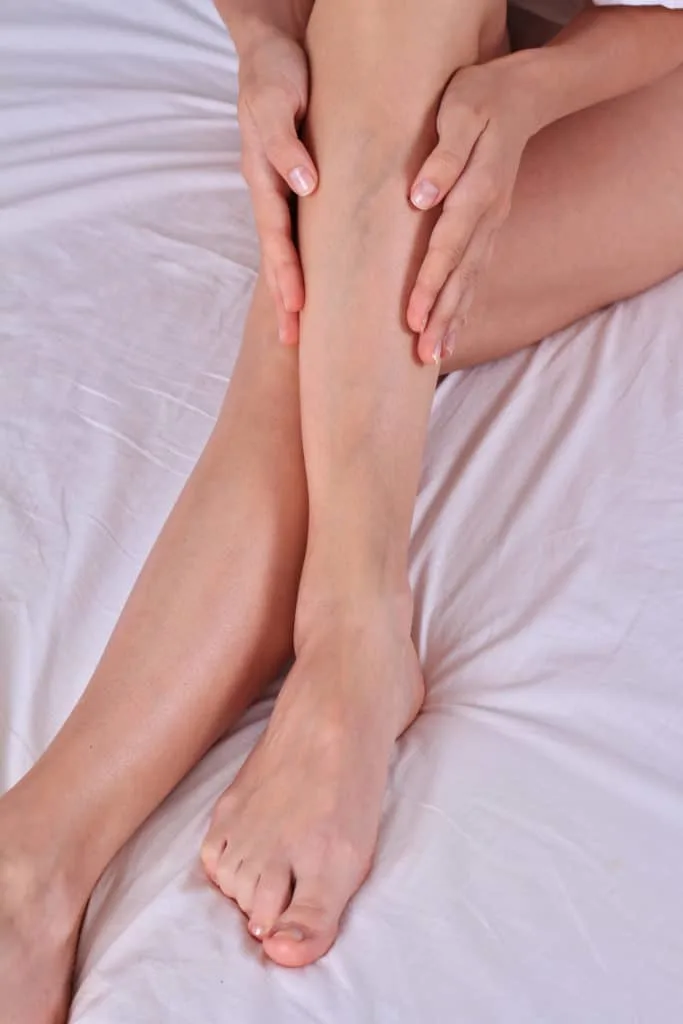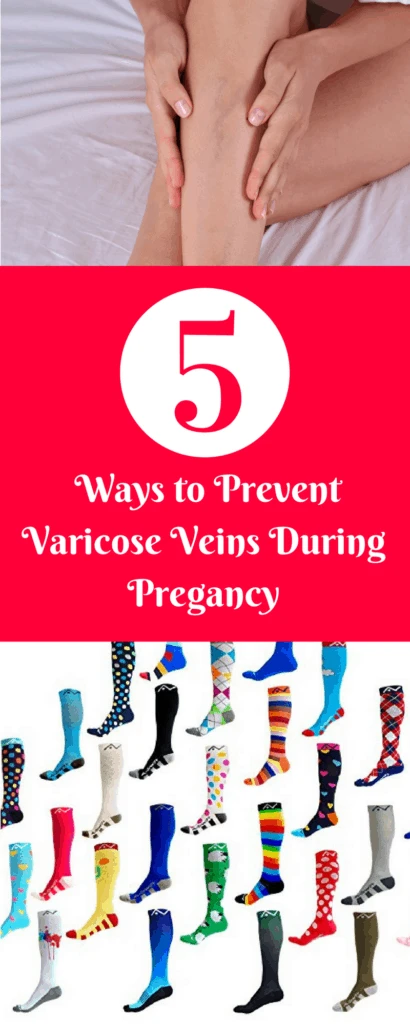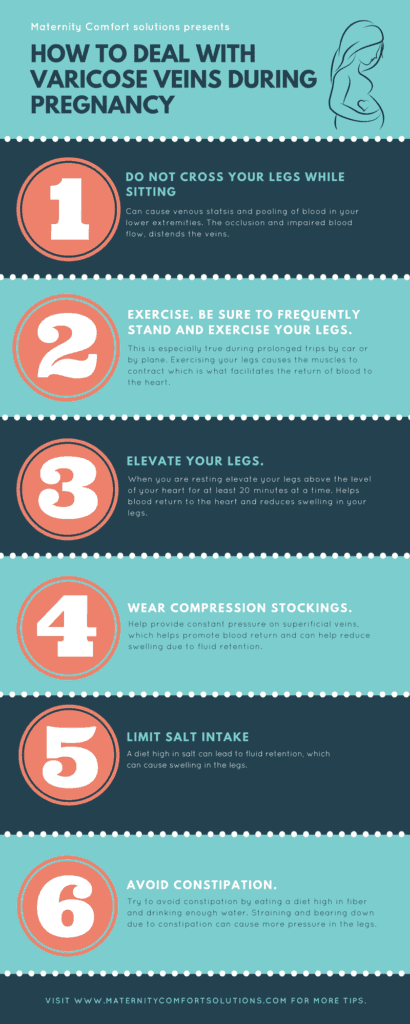
How To Deal With Varicose Veins During Pregnancy
Learn how to deal with varicose veins during pregnancy. The worsening of preexisting varicose veins or the development of varicose veins during pregnancy is not uncommon. This is due to the dramatic changes that occur in the circulatory system during pregnancy.
What are varicose veins?
Varicose veins develop when there is pooling or back up of blood in the venous circulation. Since the blood pressure in your veins is very low, there are valves in your veins to prevent blood from flowing backward. Varicose veins develop when thee valves fail to function properly allowing blood to flow backward. Pregnancy is a time when this can be exacerbated due to increased pressure in the abdomen and lower extremities.
Most are concerned about the cosmetic effect of varicose veins. Especially varicose veins near the surface that either bulge out or cause what is referred to as spider veins.
For many people, varicose veins never pose a serious problem that requires treatment unless it is for cosmetic reasons. For others, varicose veins can cause symptoms that may require treatment. As we will discuss, for symptoms that are not serious, treatment can be very simple such as using compression stockings to the more aggressive measures such as surgical removal or stripping of the veins.
For many women, varicose veins during pregnancy can be problematic due to the discomfort they cause and the complications they can cause, including phlebitis (vein inflammation) and blood clots.
In this article, we will explain why varicose veins develop and how to manage them. Also, if you are prone to developing varicose veins during pregnancy, we will discuss various ways to minimize the severity of varicose veins.
 This post may contain affiliate links, you can catch our full disclaimer at the bottom of this post.
This post may contain affiliate links, you can catch our full disclaimer at the bottom of this post.
It is common for women to discuss varicose veins during pregnancy. Unfortunately, this is because the physiologic changes that occur during pregnancy dramatically affect the vascular system.
Varicose veins are often thought to be a problem that only occurs in the legs. In fact, there are other locations in the body where varicose veins can develop. These locations can develop for the first time during pregnancy and cause problems if you are prone to developing varicose veins during pregnancy.
These other locations include:
- Hemorrhoids
- Umbilical
- Vulvar
Varicose veins form because of the difference in venous and arterial pressure (Think of the difference between a tourniquet and blood pressure cuff.)
When a tourniquet is placed on your arm to draw blood, you might notice that it is not as tight as a blood pressure cuff. The reason for this is because a tourniquet is designed to obstruct the venous return of blood to the heart.
When the tourniquet is just tight enough to block the blood flowing through the low-pressure veins, the veins become distended. (When abnormally distended or obstructed, varicose veins occur).
On the other hand, when a blood pressure cuff is applied the pressure applied is much higher. This is because the pressure being measured is the highest pressure required to obstruct high-pressure arterial flow.
Here are a few simple suggestions that may help alleviate the discomfort and overall severity of varicose veins during pregnancy. These suggestions are worth considering as they are based on fundamentally sound scientific principles and are not harmful:
1.) Do not cross your legs when sitting. This is something many people have been told and it is particularly important when done for prolonged periods of time. The reason crossing one’s legs can be a problem is because it causes venous stasis and pooling of blood in the lower extremities.
The impaired blood flows up the legs distending the veins. In addition, the forces of gravity also have to be overcome to return blood to the heart. Whether or not leg crossing actually contributes to the exacerbation of varicose veins has always been questioned.
One thing most can agree upon is that it definitely does nothing good when it comes to varicose veins and swelling of the lower extremities.
2.) During prolonged trips in your car or by plane, make an effort to frequently stand and exercise your legs as this causes the muscles in your legs to contract which is what facilitates the return of blood to the heart. The pooling of blood in the lower extremities during long trips can also contribute to the development of blood clots.
The airline industry recognizes this risk and puts signs in the airports to prevent problems with phlebitis on long flights. Another example of how important muscular contractions are to the return of blood to the heart is the often-told story of military personnel fainting when standing at attention for prolonged periods of time.
Muscular contractions and venous system valves are what keep venous blood flow moving in the right direction.
3.) Elevate your legs whenever possible to counteract the forces of gravity (as previously noted).
4.) Use compression stockings to keep the pressure on superficial veins which are part of the low-pressure venous circulation.
This will also help reduce swelling due to fluid retention while you are upright during the day.
If you choose to use stockings, it is essential that you discuss the use of stockings with your provider to be sure they fit properly and are the correct pressure. In severe cases of varicose veins, there are stockings (Jobst, Teds, etc.) which are measured and ordered by your provider.
Do not to use ankle or thigh-high stockings that have constrictive bands as they will act as a tourniquet (see above) and can make matters worse. Use full-length stockings whenever possible.
5.) Exercise Exercise is an excellent way to manage varicose veins. It is also said to be helpful in preventing them. Unfortunately, if you are predisposed to developing varicose veins (as is the case for about 20% of the adult population) exercise may not do very much to prevent them from forming.
The reason exercise, even in the form of walking, is good for varicose veins is because of the contraction of your leg muscles which helps to milk blood through the veins and back to the heart.
Women (after their pregnancy) and men who have severe, symptomatic varicose veins, may consider treatment at some point in their lives: (some, though not all, treatment options are listed below)
- stripping
- sclerosing
- laser
- topical
This article is only intended to help one understand why varicose veins develop and some ways to help prevent their progression. We cannot comment on the management of varicose veins. This can only be addressed with your provider who can evaluate your clinical findings and then based on your medical history decide on the best and safest treatment approach.
If you ever notice any redness, tenderness, warmth or swelling associated with varicose veins, you should immediately bring these concerns to the attention of your health care provider. These symptoms can be related to a serious condition called thrombophlebitis.
Thrombophlebitis is an inflammation of the veins and can lead to other problems (blood clotting etc.) The diagnosis of such a condition can only be made by your personal provider after a thorough history and physical examination.



